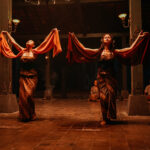October 13th, 2017, remains a vivid evening etched in my memory, marked by the mesmerizing performance of Pilobolus’ Shadowland at the George Mason University Center for the Arts in Fairfax, VA. The anticipation was palpable as the audience settled in, eyes drawn to the intriguing set – clothing, picture frames, and hula-hoops suspended from the ceiling. This eclectic collection hinted at the imaginative journey that Shadowland, a show I had eagerly awaited for years, was about to unfold.
My initial encounter with the magic of Pilobolus Dance occurred around 2011-2012 when I saw a brief excerpt of Shadowland on television. It was unlike anything I had ever witnessed before: a dance form entirely concealed behind a screen, where dancers manipulated their bodies to craft shapes and perspectives, breathing life into fantastical characters through silhouette. The Pilobolus dance company members demonstrated incredible physical control, their contorted forms captivating even in complete shadow.
Pilobolus has consistently challenged the boundaries of dance, constantly redefining “What is dance?”. Their signature collaborative choreographic process fosters innovation, generating ideas that transcend individual limitations. Shadowland is a testament to this approach, born from the collective creativity of Pilobolus dancers and directors, alongside Steven Banks (the head writer for SpongeBob SquarePants), and enriched by original music composed by David Poe, a distinguished musician, producer, and film composer. This unique blend of talents contributes to the show’s distinctive and captivating nature.
The narrative of Shadowland, while simple, is rich in dreamlike symbolism. It follows a young girl yearning for the excitement of city life who, in a surreal twist, is transformed into a dog-humanoid by a colossal hand descending from the sky. This fantastical event propels her into a dreamscape adventure filled with challenges and betrayals. The story unfolds within her dream, initiated as she drifts to sleep on a bed amusingly constructed of men, whisking her away to the ethereal realm of shadows, a perfect stage for Pilobolus dance.
One particularly memorable scene early in Shadowland features the girl stumbling upon a large, legged cauldron. Comical, distinctly French chef music fills the theater, setting the stage for a trio of zany chefs to emerge. These culinary characters embark on a chaotic stew-making endeavor, tossing in absurd ingredients like a shoe, a telephone, and even a kitchen sink. In a humorous turn, they decide the girl would be the perfect final addition, leading to a comical, Scooby Doo-esque chase through labyrinthine hallways in pursuit of their would-be ingredient. This scene exemplifies the playful and inventive spirit of Pilobolus dance.
The narrative takes a darker turn when our dog-faced protagonist is abducted by a circus. This segment, while a departure in tone, introduces a layer of complexity to the dream narrative. The circus atmosphere, inherently tinged with the bizarre and slightly unsettling, felt somewhat dissonant with the otherwise whimsical and lighthearted tone of Shadowland. However, it served to highlight the protagonist’s journey through varied emotional landscapes within her dream.
Another scene that deeply resonated was the underwater sequence. Here, the girl encounters a mesmerizing array of marine life – hand-shadow crabs, a colossal seahorse, and a dramatic encounter where she is engulfed by a giant squid-like creature. The choreography in this scene was masterful, conveying the resistance and fluidity of water through slow, deliberate movements, enhanced by lighting and special effects that convincingly transformed the stage into an underwater world. This scene showcases the power of Pilobolus dance to evoke atmosphere and emotion through movement and visual storytelling.
A defining characteristic of Pilobolus dance, and what makes it so compelling, is its emphasis on the collective. No single dancer dominates; instead, the focus is on the ensemble’s synergy. A beautiful illustration of this is the scene where the girl falls asleep and transitions into her dream. Male dancers lifted and manipulated her body with such grace and fluidity, simulating weightlessness as she floated through imaginary clouds, spiraling down into the land of dreams and shadows. The dancers became almost invisible, their movements so seamless that it felt like watching a cartoon character suspended in mid-air, perfectly embodying the dreamlike state.
The sheer aesthetic beauty of Shadowland is undeniable. The performers execute incredibly demanding physical feats, bordering on acrobatics. However, unlike a Cirque du Soleil performance that elicits gasps and cheers for daring stunts, Pilobolus dance evokes a different kind of response. There is no overt spectacle; instead, there is a sense of soothing, effortless, and beautiful movement. The focus is not on individual virtuosity, but on the collective artistry and visual poetry created by the ensemble.
Even after nearly a decade of touring Shadowland globally, Pilobolus maintains a remarkable ability to connect with each specific audience. In their encore performance that evening, they incorporated local references to Fairfax, Virginia, including mentions of the Silver Diner and George Mason University campus. This personalized touch created a sense of intimacy and demonstrated the performers’ engagement with their audience. It also hinted at the ever-evolving nature of Shadowland, suggesting that the story might continue to unfold, leaving the audience with a sense of anticipation and a warm appreciation for a performance tailored just for them. The evening was a testament to the enduring appeal and innovative spirit of Pilobolus dance.

